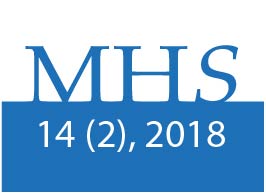RELEVANCE OF NEUROMUSCULAR EXERCISES IN THE RISK OF FALLS IN INSTITUTIONALIZED ELDERLY: PILOT STUDY
DOI:
https://doi.org/10.15359/mhs.14-2.2Keywords:
Falls, elderly, nursing homes, exerciseAbstract
Purpose: Assess the effect of a neuromuscular exercise program in the risk of falls in the elderly residing in nursing homes. Methodology: Comparative cross-sectional pre-experimental study. A total of 20 seniors, ages 68 to 80 residing in a nursing home, participated in a neuromuscular training program 3 times a week for 12 weeks. Participants were evaluated on their risk of falling using the Tinetti test prior to training, 6 and 12 weeks. Normal data distribution was verified with the Shapiro Wilk test, while instrument reliability was calculated using Cronbach's alpha and scores differences using repeated measures ANOVA. The value p < 0.05 was considered significant. Results: The analysis of data distribution showed no significant difference (p > 0.05); instrument reliability was 0.96; variance analyses identified significant differences between risk scores measured at the beginning v/s 6 weeks, 6 weeks v/s 12 weeks and at the beginning v/s 12 weeks exercise (p < 0.05). Conclusion: Neuromuscular exercises reduce the risk of falls in institutionalized elderly. Implication: In virtue of the results obtained, this type of exercise could be used as an alternative to physical activity for residents to continue to be functional, thereby reducing social, psychological and economic costs involved in a fall.
References
Andresen, E. M. (2006). Cross-sectional and longitudinal risk factors for falls, fear of falling, and falls efficacy in a cohort of middle-aged African Americans. Gerontologist, 46(2), 49-57.
Ávila, J. (2007). El Síndrome de fragilidad en el adulto mayor. Antología Salud del Anciano. Parte 2. Ciudad de México, México: UNAM.
Chung-Wei, C. (2012). Neuromuscular Training for Chronic Ankle Instability. Physical Therapy, 92(8), 987-991.
Delbaere, K. (2010). Determinants of disparities between perceived and physiological risk of falling among elderly people: cohort study. BMJ, 45(34), 4165-70.
Furtado, H. (2015). Physical exercise and functional fitness in independently living vs institutionalized elderly women: a comparison of 60- to 79-year-old city dwellers. Clinical Interventions in Aging, 10(8), 795-801.
Garber, C. (2011). Quantity and Quality of Exercise for Developing and Maintaining Cardiorespiratory, Musculoskeletal, and Neuromotor Fitness in Apparently Healthy Adults: Guidance for Prescribing Exercise. Medicine & Science in Sports & Exercise. 43(7), 1334-59.
Gusi, N. (2012). Balance training reduces fear of falling and improves dynamic balance and isometric strength in institutionalized older people: a randomized trial. Journal of Physiotherapy, 58(26), 97-104.
Hauer, K. (2006). Systematic review of definitions and methods of measuring falls in randomized controlled fall prevention trials. Age and Aging, 3(5), 5-10.
Instituto Nacional de Estadística de Chile (INE). (2012). XVIII Censo Nacional de Población y VII de Vivienda. Recuperado de http://www.ine.cl.
Izquierdo, M. (2016). Is Ethical Not to Precribe Physical Activity for the Elderly Frail? Journal of the American Medical Association, 25(4), 1-3.
Langhammer, B. (2011). Functional fitness in elderly Norwegians measured with the Senior Fitness Test. Advances in Physiotherapy, 13(8), 137- 44.
Lavedán, A. (2015). Prevalencia y Factores asociados a caídas en adultos mayores que viven en la comunidad. Atención primaria, 47(6), 367-375.
Legters, K. (2002). Fear of falling. Physical Therapy, 82(2), 64-72.
Liu, CJ. (2009). Progressive resistance strength training for improving physical function in older adults. Cochrane Database of Systematic Reviews. Issue 3.
López, J. (2015). Effect of training on an unstable balance and function in elderly. Rev. Fac. Nac. Salud Pública, 33(1), 31-39.
Martínez, A. (2017). Actividad física en el adulto mayor institucionalizado: Un enfoque epistemológico constructivista. Rev.peru.cienc.act.fis.deporte, 4(2), 448-451.
Pantoja, M. (2014). Efectos de un programa de ejercicios fisioterapéuticos sobre el desempeño físico en Adultos Mayores Institucionalizados. REGG, 49(6), 260-65.
Poblete, F. (2017). Relación entre calidad de vida, equilibrio estático y dinámico en adultos mayores. Rev.peru.cienc.act.fis.deporte, 4(2), 442-447.
Puri, KS. (2009). Declaration of Helsinki, 2008: implications for stakeholders in research. J Postgrad Med. 55(2), 131- 34.
Rodriguez, C. (2012). Validez y Confiabilidad de la escala de Tinetti para población colombiana. Rev. Colomb. Reumatol, 19(4), 218-233.
Serra-Rexach, J. (2011). Short-term, light-to moderate-intensity exercise training improves leg muscle strength in the oldest old: A randomized controlled trial. J Am Geriatr Soc, 59(4), 594–602.
Tarazona, F. (2016). A Multicomponent Exercise Intervention that Reverses Frailty and Improves Cognition, Emotion, and Social Networking in the Community-Dwelling Frail Elderly: A Randomized Clinical Trial, JAMDA, 7(8), 1-8.
Tinetti, ME y Powell, L. (1993). Fear of falling and low self-efficacy: a case of dependence in elderly persons. Journal of Gerontology, 48(3), 5-8.
Downloads
Published
How to Cite
Issue
Section
License
General conditions
MHSalud: Journal in Human Movement Sciences and Health by the Universidad Nacional is cover under a Creative Commons Atribución-NoComercial-SinDerivadas 3.0 Costa Rica license.
The journal is hosted in open access repositories such as the Institutional Repository of the Universidad Nacional, the Kimuk Repository of Costa Rica and La Referencia.
The editorial source of the journal must be recognized. Use the doi identifier for this purpose.
Self-archiving policy: The journal allows the self-archiving of the articles in their peer-reviewed version, edited and approved by the Editorial Board of the Journal to be available in Open Access through the Internet. More information in the following link: https://v2.sherpa.ac.uk/id/publication/25815



















